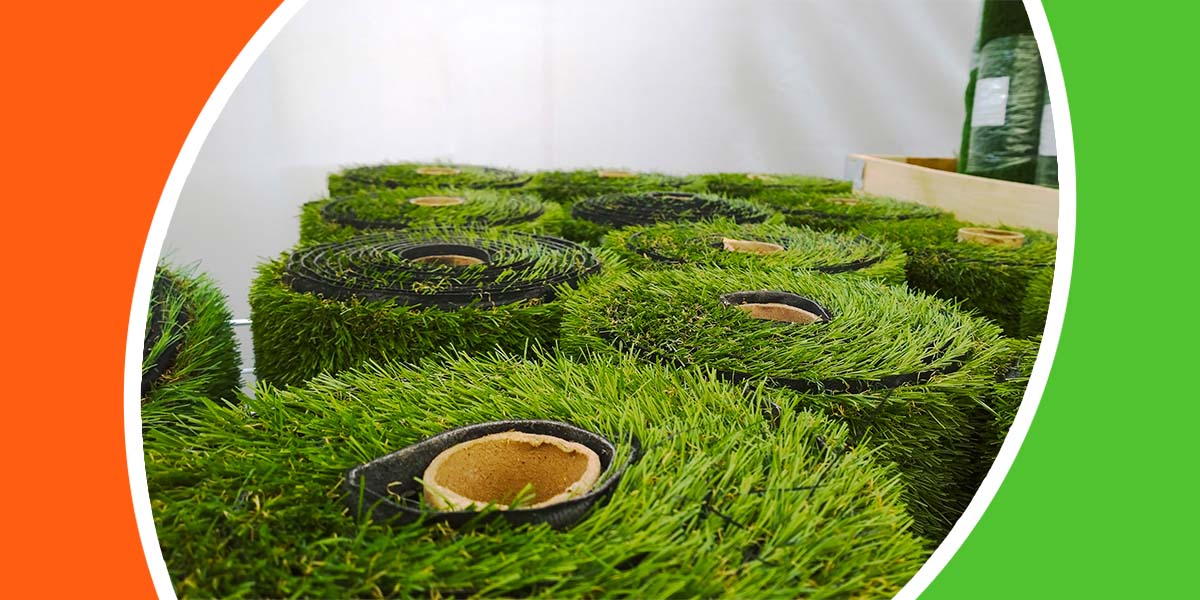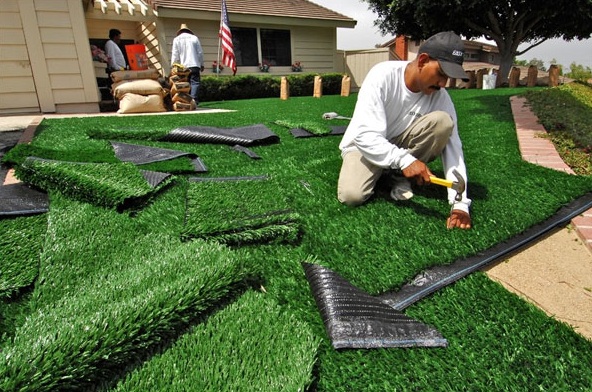See Why Homeowners Prefer Artificial Lawn for Lasting Landscape Design Practices
As homeowners increasingly prioritize sustainability in landscape design, artificial lawn has actually become an engaging choice to typical yard. Its capacity to preserve water, minimize maintenance initiatives, and lessen environmental impact settings it as a useful selection for those seeking environmentally friendly remedies. The aesthetic charm and flexibility of artificial lawn cater to diverse layout preferences. The ramifications of this change prolong past plain comfort and visual appeals, motivating a better examination of exactly how these choices affect broader ecological outcomes. What stays to be explored is the complete extent of benefits that synthetic grass can supply to house owners and the environment alike.
Water Preservation Advantages
Among one of the most significant benefits of synthetic grass is its function in water preservation. Traditional turf lawns need substantial amounts of water to preserve their lavish look, frequently causing overuse of neighborhood water sources, especially in deserts. On the other hand, synthetic grass removes this demand completely, as it does not need watering. This not just preserves water yet also reduces the strain on community water systems, particularly during drought conditions.
In addition, the installation of synthetic grass can add to an extra lasting landscape. Home owners can dramatically decrease their water expenses, enabling for reallocation of resources to other environmental campaigns or house usages. Furthermore, synthetic turf is made to withstand various weather conditions without the need for supplemental watering, making it an ideal selection for areas dealing with water scarcity.
The ecological advantages prolong past prompt water cost savings. By reducing water intake, artificial lawn helps to minimize the impacts of climate change, preserving crucial environments that are intimidated by too much water extraction. As sustainable landscape design techniques obtain grip, synthetic grass becomes a responsible selection for house owners seeking to develop eco-friendly outside spaces.
Minimized Maintenance Initiatives
Synthetic grass significantly reduces upkeep efforts compared to typical turf yards. With artificial lawn, homeowners can remove the time-consuming tasks connected with natural landscape design, such as mowing, feeding, and weeding. This not only conserves beneficial time yet also decreases physical labor, making grass care easily accessible for people of all ages.
One of one of the most noteworthy benefits is the lack of regular mowing. Standard grass require frequent trimming to preserve an aesthetically pleasing height, whereas synthetic grass remains regularly rich without the demand for reducing. Additionally, property owners no more need to apply pesticides or fertilizers, which are commonly called for to maintain natural turf healthy. This change not just lightens the workload however likewise promotes a neater, extra consistent look year-round.
Additionally, synthetic turf is sturdy and durable, needing very little upkeep beyond periodic brushing and rinsing to get rid of particles. This simplicity of maintenance allows homeowners to appreciate their outside spaces without the consistent concern of upkeep, giving even more time for leisure and family tasks. Inevitably, the decreased upkeep initiatives connected with artificial grass make it an appealing choice for those seeking a low-maintenance, visually appealing landscape.

Ecological Influence Reduction
There is an expanding acknowledgment of the environmental advantages related to synthetic grass, particularly in regards to water preservation and lowered chemical use. Traditional yards need significant amounts of water, especially in drought-prone regions, causing raised pressure on neighborhood water sources. In comparison, synthetic grass eliminates the need for irrigation, considerably minimizing water usage and promoting sustainability.
Additionally, conventional lawn upkeep frequently involves the application of herbicides, pesticides, and plant foods, which can add to soil and water pollution. Artificial lawn minimizes this ecological risk by requiring minimal maintenance and essentially getting rid of the need for harmful chemicals. This not just improves soil health yet additionally safeguards regional ecosystems from poisonous overflow.
Additionally, the manufacturing of natural lawn yards usually entails using fossil gas for cutting and landscaping equipment, further adding to greenhouse gas discharges. By choosing synthetic grass, home owners can dramatically lower their carbon impact connected with lawn treatment activities.
Visual Appeal and Adaptability
In enhancement to its environmental advantages, man-made lawn provides considerable visual allure and flexibility for landscaping. Home owners can accomplish a rich, environment-friendly look year-round, eliminating the seasonal changes frequently related to all-natural grass. This consistent visual not only enhances the visual charm of a residential or commercial property however likewise adds to a properly maintained and sleek look.
Moreover, synthetic grass is offered in a range of colors, styles, and textures, permitting personalization to fit private preferences and design themes - Phoenix turf companies. Whether utilized in domestic gardens, commercial rooms, or entertainment locations, it can effortlessly integrate into varied landscape design styles, from modern minimalist to lavish exotic settings
The versatility of artificial lawn expands beyond mere look; it can be set up in various areas, visit the site consisting of rooftops, patio areas, and also indoor rooms, producing opportunities for unique landscape design services. Additionally, it is ideal for a series of activities, from youngsters's backyard to pet-friendly environments, giving performance without compromising design.
Ultimately, the visual appeal and convenience of man-made turf make it an eye-catching option for home owners seeking lasting landscaping remedies that do not compromise view it now elegance for environmental duty.

Long-Term Price Financial Savings
Among one of the most compelling benefits of synthetic grass is its capacity for long-term cost savings. Unlike natural lawn, which requires routine upkeep-- consisting of mowing, watering, feeding, and bug control-- synthetic grass dramatically minimizes these continuous expenditures. Homeowners can conserve a considerable quantity on water expenses, especially in regions where water scarcity is a pressing problem. The elimination of grass treatment solutions additionally adds to economic cost savings, as there is no need for specialized devices or labor.
In addition, artificial turf has a life-span of 15 to 25 years, depending upon its quality and use. This durability decreases replacement costs, making it a more affordable choice over time. The first financial investment in man-made grass can typically be recouped with the financial savings built up over time.
While the in advance expense might seem higher compared to turf installation, the advancing cost savings from minimized maintenance and water use typically exceed these first expenses. Ultimately, the adoption of synthetic grass not just promotes a sustainable landscaping service but likewise provides homeowners an economically savvy choice that straightens with lasting budgeting goals.
Verdict
Synthetic lawn arises as an engaging option for lasting landscaping, supplying substantial benefits in water conservation, find more information lowered upkeep initiatives, and decreased environmental effect. As communities progressively focus on eco friendly methods, the fostering of man-made turf stands for a dynamic action towards accomplishing durable and lasting landscapes.
In addition, fabricated grass is developed to hold up against various weather conditions without the demand for supplementary watering, making it an optimal choice for regions dealing with water deficiency. (Phoenix turf companies)

By lowering water intake, fabricated lawn helps to alleviate the effects of environment adjustment, preserving essential communities that are intimidated by too much water extraction.There is a growing recognition of the ecological advantages linked with synthetic lawn, specifically in terms of water conservation and decreased chemical usage. In comparison, man-made grass gets rid of the need for watering, considerably minimizing water intake and promoting sustainability.
Synthetic lawn arises as an engaging alternative for sustainable landscaping, using substantial advantages in water conservation, decreased maintenance efforts, and diminished ecological impact.